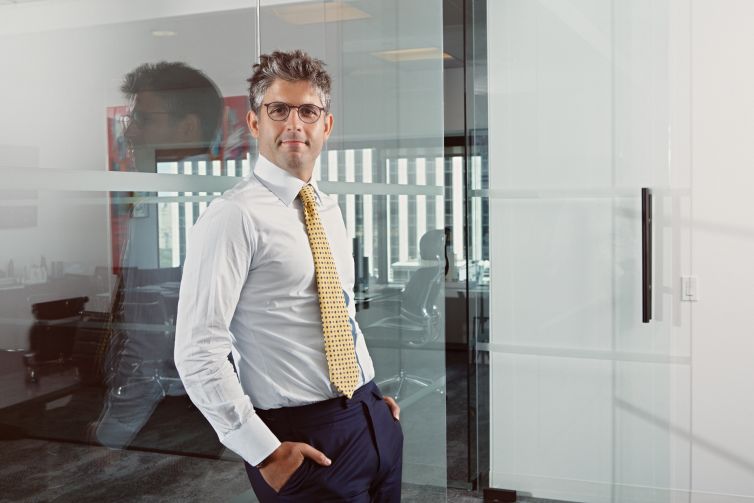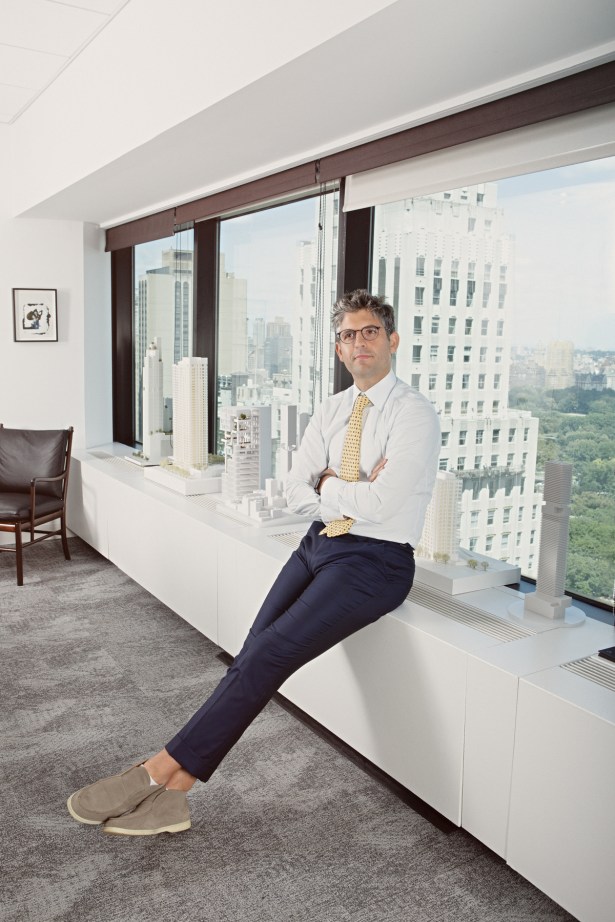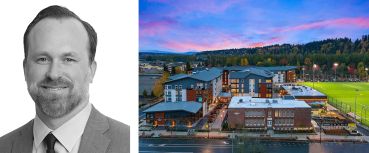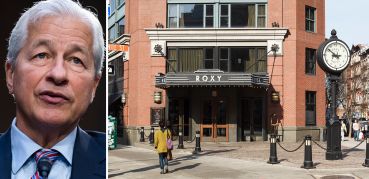In the Heights: Casey Klein Is Taking the Development Long View
By Cathy Cunningham September 4, 2019 11:00 am
reprints
If you’re a lender capable of taking down $500 million loans, chances are you’ve crossed paths with Crescent Heights’ Casey Klein. The 34-year-old principal has been busy recalibrating and refinancing the developer’s existing portfolio lately — enjoying the low interest rate environment and tight spread market — and getting a wave of new projects underway.
The Miami-based company specializes in the development of residential and mixed-use properties, office buildings, and hotels. Its assets include Ten Thousand, a 40-story luxury residential property in Santa Monica; the Palladium Residences on Sunset Boulevard in L.A., two soon-to-be luxury residential towers designed around the preservation and restoration of the historic Hollywood Palladium theater; and three properties constructed under the firm’s NEMA lifestyle apartment brand in San Francisco, Boston and Chicago.
Klein talked about all that and more with Commercial Observer.
Commercial Observer: Are you a Manhattanite?
With Casey Klein: Yes, I am.
How did you get into real estate?
My father is a contractor, but I always had an appreciation for real estate. I liked the idea of being able to look at what you’re working on and it being tangible. I moved to the city when I was in eighth grade and enjoyed looking at buildings back then, and — as I’ve now learned in my career — you can understand the underlying financials and be involved in creating something by adding value to something that you’re looking at.
Did you have a favorite building growing up?
I always admired the Chrysler Building, just from an architectural significance perspective.
What was your first job out of college? [Klein studied real estate and finance at George Washington University in D.C.]
It was with Crescent Heights! I’ve been at Crescent for 13 years now. I started out in Miami and really had no interest in coming back to New York after school. I wanted something different, some change, and Miami was a great place to be fresh out of school, as you can imagine. I was down there for many years and then I moved back to New York in 2013.
What was your role when you first joined?
I was really an acquisition analyst but my relationship with the senior principals quickly grew and I became a consummate jack-of-all-trades hustler. I would travel around the country with [Crescent Heights Chairman] Sonny Kahn and work closely with [Crescent Heights Co-Founder] Russell Galbut on a variety of entrepreneurial things. I then evolved into an acquisitions-focused role and did a lot of our national development acquisitions during the downturn and looked at a lot of large structured purchases. I spearheaded a lot of our acquisitions and continued to scale the ladder.
You joined the company in 2006 and the crisis began a year later, which must have been a pretty interesting time to learn the ropes.
What was, and is, really exciting about being at Crescent is the entrepreneurial and proactive nature of our owners — now my partners — and their great foresight. We were very fortunate because of our national scale at the time … foreshadowed the downturn in the financial crisis and over time we liquidated our inventory and got out of the market completely. So, it was really mesmerizing coming out of school to have a front row seat and watch a large organization that had approximately 15,000 units in the market around the country liquidate on a retail level over two years. Whether we were selling buildings or inventory that was really a directive from the top, [it] was very interesting.
Were you also acquiring opportunistically at that time?
No, we stopped acquiring assets in the end of 2006. We didn’t acquire anything new until the end of ‘09. So we were able to take advantage of the market and that was great for me and my career; we’d been liquidating and sitting on a lot of cash we were able to buy a lot of distressed assets. We bought some of the most notable deals in our portfolio today — whether it’s Ten Thousand Santa Monica, or Jasper which we recently sold in San Francisco [the high-end apartment property sold to Northwestern Mutual in March]. All of those land purchases were distressed land opportunities. We bought very aggressively from lenders, special servicers, repo line holders. It was great to be able to do that and really be in the thick of it, leading those deals.
Today Ten Thousand is a luxury property with 283 residences. What was the story behind its land acquisition?
It was owned by a developer but we bought it from a Lehman Brothers repo facility holder, Danske Bank. We were able to acquire it directly from them. Lehman Brothers had financed the land, financed the developer’s equity and also the developer’s [planned] development.
How did you have the foresight to know what was going to be a savvy acquisition opportunity at the time?
We historically as a firm process a lot of deal flow in all different sectors, whether it’s office, retail, multifamily or development opportunities. And we saw at the time that we had focused only in the markets that we had been in the previous cycle. So we were looking at San Francisco, Los Angeles, South Florida, Atlanta, Chicago, Boston and Seattle. We were very keen on getting very aggressive on the best, well-located projects at the time. We had no legacy issues so were able to focus on new business initiatives. Ten Thousand is one example of what we knew was the best location in a gateway city, and somewhere you’d never be able to replace the real estate.
How has Crescent Heights’ business strategy changed over the past 13 years?
[Back then] I’d say 90 percent of our business at the time was for-sale inventory and condominium conversion and development, and the balance was multifamily and other use. We do some for-sale opportunities selectively where we see fit, but we certainly have migrated towards a sort of build and hold model. We’re consummate entrepreneurs and we’ll listen to everything. But we go into projects now with more of a longer-term view.
How much of your activity is acquisition-focused versus redevelopment or ground-up construction?
I think today 70 percent of our business is new development and the balance is value-add acquisitions, whether it’s office or repositioning residential multifamily buildings. Buying existing or value-add opportunities is a lot harder today. And so we’re priming ourselves on a lot of the land that we’ve bought over the last five to 10 years and getting those sites ready for entitlement or development.
How do you like the development side of the business?
I love it. It’s a place where you can apply all the different parts of the real estate spectrum, if you will. That’s a benefit I’ve had at Crescent, being involved in acquisition, design, marketing all the way through financing and touching each part of the business. It’s something that was always attractive to me in real estate; that’s why I came into it and that’s what makes me continue to do it.
When it comes to construction financing do you tend to work with the same lenders?
We’ve worked with a whole host of fixed-rate lenders and are always looking to expand that roster. We’ve had a lot of success with our existing cadre of lenders whether it’s ULLICO, who’s a very close relationship of ours, or Bank OZK, Blackstone, Helaba, Bank of China. Part of our mantra is we never want to do one deal with anyone. It’s always about doing repeat business because that’s how [a relationship] amortizes itself in terms of time and energy.
On a Commercial Observer L.A. panel in June, you described how you value the post-close relationship in construction deals.
I think the post-close relationship from a borrower and also a servicing perspective is very important to us. It’s easy to get in and hard to get out, meaning it’s always easy to sign up a deal but when you’re working a deal nothing ever goes according to the plan; there’s always deviations for the better or for worse. And you want to have a servicing relationship that is always proactive and responsive, because a quick no is better than a slow maybe. Then there’s scale, none of our projects are small. We do $500 million to $600 million development financings and these are $800-million-dollar projects. So we look to build relationships with folks that have the balance sheet capability to deliver. It also comes down to structure, it always comes down to financials, but I think the responsiveness and that working relationship is most important to us.
Do you sense the construction financing side of the industry is getting more competitive as lenders search for opportunities?
I think for certain projects and allocations there is always a ton of competition. The bench is very deep. That said when you go up in size the competition from the banks certainly becomes less competitive, and they have been outmatched by the debt funds and the creative lenders who have become very, very aggressive in providing solutions. I think run-of-the-mill projects will struggle to be financed today. But I think when you have something unique, there is a ton of capital, which is propelling the cycle.
You tap the CMBS market for some of your refinancings; what’s your take on it right now?
The CMBS market works for large deals and deals that are run-of-the-mill. It’s a great execution. It’s very aggressive but tough sometimes from a servicing perspective, so you don’t want to use it for a complex deal. You really want to use it for a ‘set it and forget it’ deal. So, a deal that is income-based or wouldn’t be able to be financed by a conventional life insurance firm or debt fund in this market. But it’s certainly an efficient cost of capital.
You have several NEMA-branded properties, which is short for New Market. Can you speak to these projects?
NEMA San Francisco was the first NEMA which was really a pioneering project in the Tenderloin District. We built that when no one believed that we could get construction financing for it. That has proved to be a phenomenal success and we felt like we were delivering something that was unique to the multifamily sector that provided best-in-class amenities and units but also the service and the lifestyle and the building of a community was really unique. The market really reacted well; it’s still one of the top performing and highest performing assets in that market. Credit to one of our principals Bruce Menin for then saying, “Hey, we can replicate this throughout our portfolio in different markets.” So, today we’ve just completed NEMA Chicago which is 800 units and the tallest rental tower in Chicago. Rafael Viñoly designed it and Rockwell did the interior design. It’s been very well received by the market. Then, we’re rolling a NEMA project out during fourth quarter this year — 414 units — in the Seaport District of Boston. We’re really speaking to the same user that expects service, expects a highly amenitized community and also an aesthetic that you otherwise would not find in these markets. Every project speaks to its market, so NEMA San Francisco speaks to that market’s design, NEMA Chicago speaks to the architecture of the city and also the importance of the local community there, and with NEMA Boston we’re embracing the seaport culture — so what it is and what will exist in the future.
There’s so much buzz about the Boston Seaport.
So much activity. It’s phenomenal there. Boston has always been a great market and very hard to enter. In 2014 we took a contrarian view on a site that was on the outskirts of the Seaport. We took a very long view and said, “This is a fee simple site which is unique, and the Seaport and other things will fill in around it.” And, sure enough, we’ve been very fortunate.
Do you have a crystal ball? Is that what’s going on here?
No [laughs]. As our chairman says, it’s 95 percent luck, five percent good luck.
Last year you received a bridge loan for your Hollywood Palladium project [Crescent is constructing two luxury residential towers on a former parking lot adjacent to the historic theater]. How’s that development going?
It’s going very well. That’s been a long slog. We’ve been going through the entitlement process there for six years. But that’s what makes it a very special site. It’s really in the center of Hollywood. We’ll build 750 or so units there and retail around the historic Palladium Theater which will stay in place. It’s going to go through a nice retrofit. It’s a phenomenal and special project that we hope to break ground on in the first or second quarter of next year. And that will also be a NEMA project, hopefully. We’re currently having discussions with folks about the construction financing. It’s too early to talk about, but we’re working on it.
You purchased a Staples-occupied building in Biscayne Bay, Florida, earlier this month. What are your plans for it?
Two of our senior principals reside in South Florida and we’ve been headquartered there for many years. We’ve been very longtime acquirers of land within the Biscayne corridor and own seven-and-a-half acres from 29th Street to 31st Street on Biscayne Boulevard. We also own the 22nd Street block of Biscayne Boulevard. This was just a smart, long-term land-bank with income from Staples, so we just took the long view.
So, no plans for anything different development-wise?
Not right now. It’s going to continue to operate as it is and obviously the development upside rests in the future.
What’s keeping you busiest right now?
We’re doing a lot of pre-development work and design work. We’ve recalibrated and restructured and refinanced our existing portfolio — given the low interest rate environment that exists today and tight spread market. We’ve worked with our existing lenders to tighten some of the financing that we have in our portfolio and now we’re looking out towards the world, at where we want to play on the acquisition front. We’re looking at deals in London as well as in other cities; I’m spending my time in all these different places.
Are there any expansion plans that you’re mulling in the U.S.?
We’re spending some time in Nashville and around Denver. We do like Austin, but it’s been very hard for us, as I think we’re late there. But we’re looking around those markets.
Do you think that we’re in a healthy real estate market?
It’s really hard for me to say. Some people say we’re in the eighth inning or the 12th inning, right? Maybe I’d say we’re in overtime with this basketball game. But look, I think there’s a lot of capital out there and I think the macroeconomic climate is causing a little confusion as to where we are. But, that being said, there is always going to be distress for projects that were not meant to be built and were over-levered. Real estate is a local market; it’s due diligence, due diligence, due diligence not location, location, location.
Is there anything that keeps you up at night?
My daughter [laughs]. I have a 4-year-old daughter and a 2-year-old son. [But] nothing keeps me up at night within our business. I think we’re very well-prepared for anything that comes our way, whether it’s opportunities or surprises in the market.
What do you do for fun?
The most fun thing for me is being with my kids and my wife, Loren. Some would say I’m a clothes horse, as I like fashion. I also love to travel, and I love sports; I’m a big basketball guy.
Who’s your team?
The Knicks are my team. We pray for better days.



